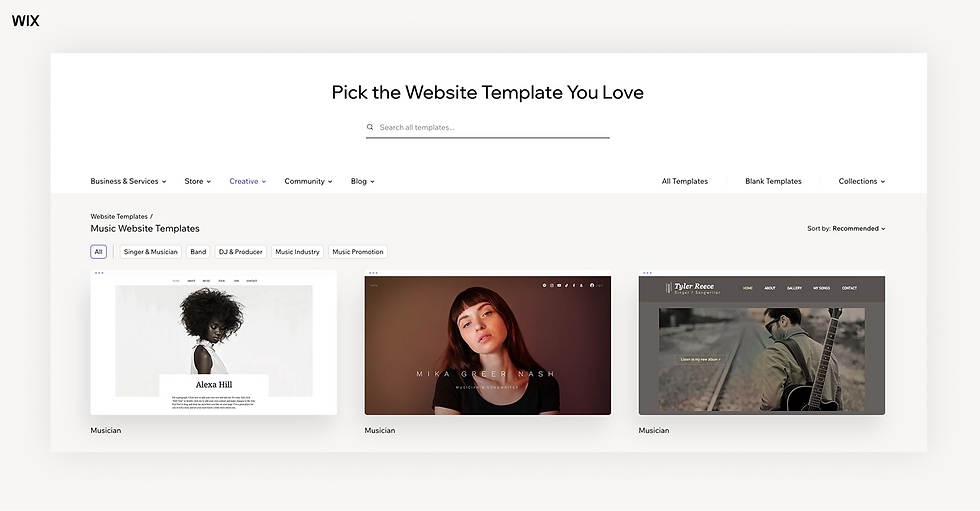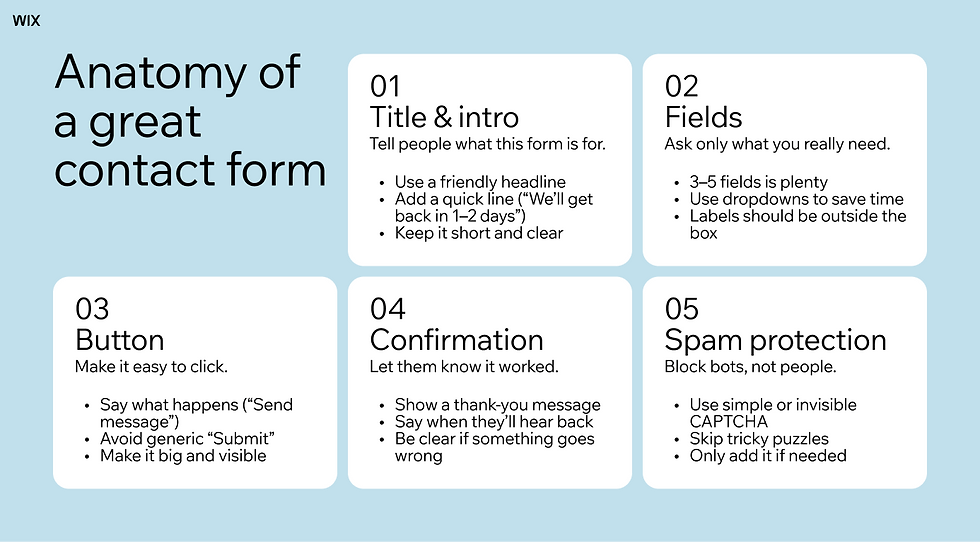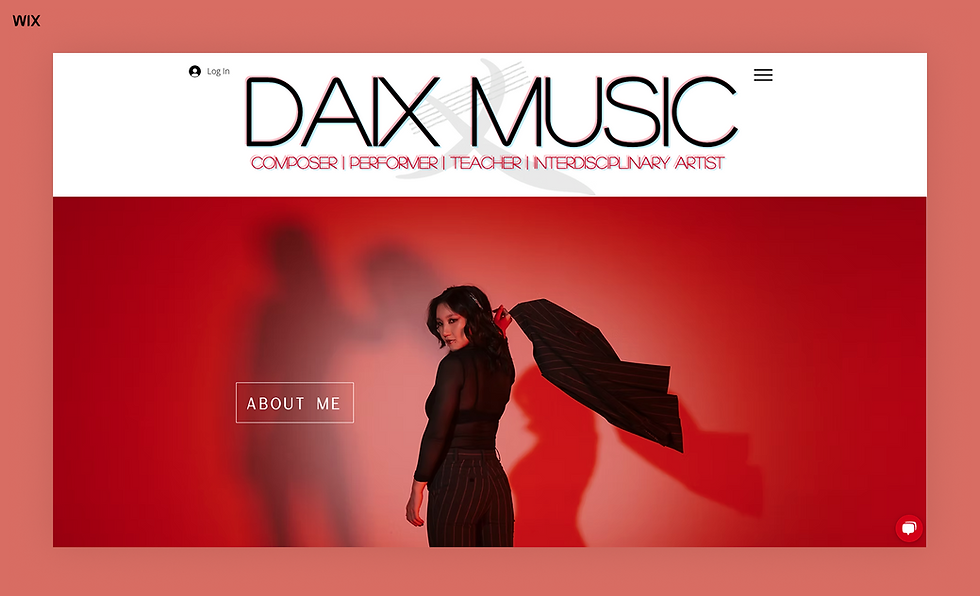- Chaya Arbiv
- Jul 14
- 13 min read
Updated: Jul 31
Ready to showcase your best work? Start building your portfolio →

Musicians need a website—whether you're releasing your first EP, scoring films or booking live gigs, a dedicated music website gives you a home base for your work: a place to showcase your sound, build your brand and get discovered.
These days, learning how to make a website isn’t just for tech pros. With the right website builder—or even an AI website builder to speed things up—you can create a professional website without any technical skills. From customizable website templates to built-in music players and contact forms, everything you need is already at your fingertips.
In this guide, we’ll show you what to look for in the best website builders for portfolios and how to make a portfolio that highlights your talent, tells your story and helps you grow your audience. Whether you're launching your first site or refreshing your brand, we’ll walk you through every step—from finding your niche to promoting your work online.

With Wix’s portfolio builder, you can create a professional, eye-catching portfolio that shows your best work in just a few clicks. Wix’s customizable portfolio templates and easy-to-use tools let you present your skills with confidence–leaving a lasting impression on anyone who visits your site.
TL;DR: how to make a music portfolio

No time to read the full guide? Here’s a quick breakdown of the essential steps to creating a music portfolio that reflects your style, goals and professionalism. Whether you're sharing original tracks, offering services or booking gigs, these are the key pieces to include when building your site—and a great place to start if you're exploring how to start a music business online.:
Steps | What you'll do |
Define your niche | Focus your portfolio around your genre, services or target audience |
Choose a domain name and hosting | Pick a domain name and secure reliable hosting for your site. |
Pick a website builder and template | Use a website builder and music template to design your portfolio |
Add music and visuals | Upload audio, videos and branding elements like your logo |
Include contact info | Make it easy for fans, clients and collaborators to reach you |
Optimize for visibility | Add SEO and start a blog to drive traffic and grow your presence |
Keep it updated | Refresh your content regularly to stay current and professional |
What is a music portfolio?
A music portfolio is a dedicated website that represents you as a musician. It brings together your audio tracks, videos, biography, press mentions and contact details in one professional, easy-to-navigate space. Many artists choose to build theirs using the best portfolio websites, which offer customizable templates and tools designed specifically for showcasing creative work online.
At its core, a professional portfolio helps you make the right first impression. Whether you're looking to book gigs, land a licensing deal or attract collaborators, your site should reflect both your artistic identity and your career goals. Knowing how to make a portfolio that feels intentional, polished and easy to navigate is essential to standing out in today’s music scene.
"Your portfolio isn’t just for showing off your music—it’s for opening doors. Whether it’s gigs, collabs or press, this is where the right people find you." - Sharon Hafuta, SEO blog editor at Wix
How to make a music portfolio
01. Define your niche

Start by narrowing in on your niche—are you a session guitarist, a composer for film and TV a live performer, or something in between? The more specific you are, the easier it is to create a portfolio that resonates.
Explore different music business ideas that align with your skills, whether it’s selling beats, offering virtual lessons or licensing your tracks. Then, pair your content with intentional web design that reflects your sound and brand.
From layout to typography to imagery, everything should work together to communicate who you are and what you do. Most importantly, this focused approach lays the foundation for how to make money as a musician—helping potential clients, fans and collaborators immediately understand the value you bring.
“A niche website is a site that focuses on a very specific topic. Instead of addressing general themes, these pages focus on a particular segment and strive to provide high-quality and relevant content for the reader.” - Emilio García, SEO podcaster and educator at Campamento Web
02. Pick a domain name and website host

Your music portfolio deserves a space online that’s as unforgettable as your work. Nail the details by starting with a professional domain name. Keep it simple, easy to spell and true to your brand as a musician. If your name is available, grab it. If not, tools like a domain name search or a domain name generator can help you brainstorm the perfect fit.
Once you've locked in a domain, it’s time to get your site running smoothly. The next step? Reliable hosting. To keep things easy, look for platforms that combine hosting with domain options. This way, you can avoid the hassle of juggling multiple providers. Check out free website hosting and explore how to host a website that brings your video portfolio to life.
With the right setup, you’ll have a polished, professional site that’s ready to wow clients.
"My biggest rule is: your domain should instantly communicate what you do. I've seen too many businesses get clever with wordplay and lose potential customers who can't figure out their service from the URL alone." - Ronak Kothari, Owner, Ronkot Design, LLC
Learn more:
03. Choose a website builder and template

Picking the right platform to build your music portfolio is a game-changer. Start with the best website builders for musicians—these platforms are crafted for creatives like you, making it easy to design a space that shows off your talent.
Once you’ve found a builder that fits your needs, it’s time to explore website templates. These pre-designed layouts give you a strong starting point and save you loads of time. If you want something tailored to your craft, look for portfolio website templates, especially music website templates and EPK template designs. They’re designed specifically to highlight musical work, ensuring your music takes center stage.
Use built‑in logo maker tools to craft your visual identity—the best website builder for musicians will help you learn how to design a logo or how to make a music logo that fits your sound and brand.
You might also be interested in:
04. Let your best work shine

Include high‑quality audio samples, embed streaming links or upload video performances. Organize tracks for easy listening—maybe categorize by mood, project type or release.
Keep your portfolio layout clean and easy to browse, ensuring your best work stays front and center. With a polished selection, you’ll leave a lasting impression that speaks to your creative strengths.
Learn more:
05. Include contact information

Adding your contact information to your music portfolio is a simple but essential step to connect with potential collaborators or fans. Include your email address, phone number and any relevant social media or professional profiles.
A contact form can be a great addition too, offering a quick and convenient way for visitors to reach out directly through your website. Consider pairing it with a well-structured contact us page that includes clear details about how and when people can get in touch. You can also explore different contact form designs to match your site's look and encourage more engagement.
To go one step further, think about how to monetize a website as you build your music portfolio. For example, you could offer downloadable products, feature ads or create a section where clients can directly book your services. These options not only make reaching out easier but also open up new ways to grow your income.
06. Optimize your music portfolio
Once your music portfolio is live, it’s time to make sure people can actually find it. This is where SEO features come into play. Look for tools that let you customize metadata, add alt text to images and improve your site’s loading speed—all of which help search engines understand and rank your site. A well-optimized portfolio not only looks good, it performs better in search results.
But visibility isn’t just about search engines. Smart marketing strategies can amplify your reach and keep your audience engaged. Consider adding a newsletter sign-up, linking your social media accounts or embedding videos that give fans a behind-the-scenes look at your process.
Another powerful optimization move? Learn how to start a music blog on your portfolio. Blogging gives you a space to share updates, stories or even thoughts on the industry—while also giving your site fresh content, which is great for blog SEO.
If you’re new to content creation, don’t worry. You don’t need to be a writer to start a blog—just speak in your own voice. Share gig recaps, behind-the-scenes photos or your latest gear picks. Not only does it help your fans connect with you, but learning how to start a blog also builds long-term traffic and authority around your name.
"Good SEO isn’t just about keywords—it’s about understanding what your readers are searching for and creating content that fulfills their needs. Following this approach builds trust and keeps your readers interested enough to come back." - Sharon Hafuta, SEO blog editor at Wix
07. Keep your music portfolio updated
Launching your music portfolio is a major milestone—but keeping it updated is what keeps it relevant. A static site can feel abandoned, while a portfolio that evolves with your music shows that you’re active, intentional and in demand. Whether you’re dropping new tracks, announcing a tour or landing a media feature, your site should reflect your latest moves.
Regular updates help build trust with your audience and show industry pros that you’re serious about your work. Even small changes—like tweaking your bio, adding a new performance photo or swapping out older songs—can make your portfolio feel fresh and engaging.
Beyond the basics, you can use your portfolio as a hub for everything happening in your music career. Add a press section or downloadable EPK to support booking and media opportunities.
Highlight testimonials, reviews or quotes from collaborators to build credibility. You can even embed an online scheduler to showcase upcoming gigs or release dates and include a newsletter signup to grow your fanbase.
Pro tip: The more touchpoints you add, the more valuable your site becomes—not just as a place to listen to your music, but as a central piece of your brand and business.
"An outstanding portfolio is all about storytelling. It’s not just a showcase of work but a narrative that weaves together a professional’s skills, creativity, and personality. Features like dynamic presets, AI setup and beautiful templates let creators bring their stories to life, ensuring that every portfolio not only stands out for its aesthetic appeal but also tells a compelling story about the creator behind it." - Hani Safe, product lead at Wix
08. Final checklist
Quick checklist: what to keep updated on your music portfolio
What to update | Why it's important |
New music or videos | Keeps your work front and center and shows your growth |
Upcoming shows or events | Lets fans and industry contacts know where to find you |
Press mentions or blog posts | Adds credibility and supports SEO |
Bio, photos and branding | Reflects your current image and sound |
Contact info and social links | Ensures no missed opportunities or outdated details |
Testimonials or reviews | Builds trust with potential collaborators or clients |
Newsletter signup or gig calendar | Helps grow and maintain your audience |
Think of your portfolio like your setlist—it needs regular updates to stay relevant. A simple checklist keeps you on track so your audience always sees the best, most current version of you.” - Sharon Hafuta, SEO blog editor at Wix
Music portfolio examples built on Wix
When reviewing the best music portfolios, we look for more than just clean and modern website design. The strongest sites blend personal branding, strategic content and thoughtful user experience to create a digital presence that feels as polished as the music itself.
Whether you're browsing for inspiration or building your own site, these examples offer a blueprint for success—especially if you're also looking into things like resume website examples, the best personal website builders or tips on how to promote your music online.
Here’s what we look for when evaluating standout music portfolio websites:
Strong first impression: The best home pages instantly communicate the artist’s sound and personality through design, imagery and layout.
Clear website navigation and structure: Visitors should easily find music, bio, press, contact and booking info without digging.
Stylish and functional blog sections: While not always included, sites that use the best blog templates can share updates, behind-the-scenes stories or tour diaries that support SEO and audience connection.
Branded visual identity: Great portfolios are visually consistent, from colors and fonts to logo and photography.
Calls to action that work: Whether it’s to listen, follow, book or subscribe, every great site guides users toward meaningful next steps—key for musicians looking how to promote music effectively.
Below are four standout Wix-built examples that hit all the right notes.
01. Ella Pearl Marcus

Ella Peal Marcus's music portfolio is a masterclass in minimal web design done right. The homepage opens with a soft, atmospheric portrait and a simple call to action that immediately puts the focus on her voice. Her most recent tracks are front and center, with embedded audio players that invite listeners to engage right away.
The navigation is clear and intentional, with a clean layout that reflects a confident, professional brand. This is a perfect example of how to create a professional portfolio that speaks volumes with restraint.
Inspired? Here’s the exact Wix template behind this music portfolio:
Template name: Musician website template
02. Machinery Inside

Machinery Inside leans into bold, expressive design to reflect their gritty, experimental sound. The homepage opens with a full-screen video loop that immediately sets the tone—raw, industrial and visually magnetic. Custom typography and a grid layout give the site structure without feeling rigid, and there's a sense of movement throughout that mirrors their high-energy performance style.
The site doubles as an interactive press kit, with a scrollable timeline of shows, releases and collaborations. Embedded music players, large-format photos and well-placed calls to action give visitors a layered experience.
One standout feature is their fan club section, where supporters can sign up for exclusive content—giving the site a community-driven feel and creating an additional revenue stream.
Even their booking options are designed with clarity in mind. There's a dedicated page where potential clients can view services, see transparent pricing and easily get in touch—no guesswork, no back-and-forth. It’s a great example of how musicians can turn their portfolio into a fully functional business tool, combining immersive storytelling with real music business ideas that make it easy for fans and collaborators to take action.
Inspired? Here’s the exact Wix template behind this music portfolio:
Template name: Dark theme musician website template
03. Daix Music

Daix Music's portfolio is a bold, immersive experience that blends sharp design with rich content. The homepage immediately sets the tone with dark visuals, motion graphics and a persistent audio player that lets visitors explore her music without interruption. The color scheme, custom fonts and genre-inspired branding all work together to create a clear, confident identity. Testimonials are front and center on the homepage, adding credibility, while her interactive contact page—complete with standout contact form designs—makes it easy for fans and collaborators to reach out.
Beyond the visuals, the site is built to support every part of her music career. A well-maintained blog gives fans behind-the-scenes updates and personal stories, while embedded YouTube videos throughout the site showcase live performances, music videos and more. Her services page clearly outlines what she offers, complete with package details, and her event schedule helps followers stay in the loop. It’s a strong example of how to combine style with strategy to create a music portfolio that looks professional and works as a business tool.
Inspired? Here’s the exact Wix template behind this music portfolio:
Template name: Colorful musician website template
04. Stephen Elsinger

Stephen Elsinger music portfolio delivers an elegant, editorial-style experience that feels more like a personal journal than a static website. The homepage flows seamlessly into a full-length story: from artist bio to music samples, media coverage and recent news—all laid out in a smooth, scroll-based design.
Each section is thoughtfully spaced and visually cohesive, balancing white space with warm imagery. The embedded audio players don’t interrupt the user experience and subtle hover effects bring a tactile sense to the visuals. His press section reads like a portfolio highlight reel, and his contact page includes both a custom form and social links. This is one of the best portfolio websites we’ve seen for artists with a story to tell.
Inspired? Here’s the exact Wix template behind this music portfolio:
Template name: Acting resume website template
"Building on Wix was honestly easier than I expected coming from a music production background. The drag-and-drop functionality let me focus on content strategy rather than coding, which was perfect since I was simultaneously managing 500+ podcast episodes and growing my team to 21 people." - Favour Obasi-ike, Project Scheduler, Work & PLAY Entertainment
How to make a music portfolio FAQ
What should I include in a music portfolio?
A strong music portfolio includes more than just your tracks. Start with your best audio and video work—high-quality recordings that reflect your current sound. Add a compelling artist bio that tells your story and outlines your background, inspirations and musical goals. Include any press mentions, testimonials or quotes from collaborators to build credibility. Your contact info and social links should be easy to find, and if possible, embed a contact form to streamline communication. Bonus elements like an event calendar, newsletter signup or even a blog can further engage your audience and set you apart.
Can I use website templates to create my music portfolio?
Yes, using a customizable template helps beginners build their own website with ease. Want a head start? Explore these free portfolio template to get started:
Template includes:
Homepage
Music and video embedded integrations
About page
Contact me form or page
Free portfolio templates on Wix:
Learn all about Wix templates to find the perfect match for your portfolio.
Can I build a music portfolio for free?
Yes—many platforms, including Wix, offer free website hosting and allow you to build a site at no cost using a subdomain. This is a great starting point for emerging artists or those testing the waters. However, to unlock more advanced features—like connecting a custom domain, removing ads or accessing premium design tools—you’ll likely want to upgrade. Using a website builder with built-in music features ensures you have the flexibility to grow your portfolio as your career progresses.
Is a music blog necessary?
While not essential, a blog can be a powerful tool for musicians—especially if you're new to sharing your work online. For those exploring blogging for beginners, starting with a music-focused blog is a great way to ease in. You can post tour updates, new release announcements, behind-the-scenes stories or reflections on your creative process. It doesn’t have to be long-form content—even a few thoughtful paragraphs help your fans connect with you on a deeper level.
Plus, from an SEO perspective, keeping your blog active boosts your visibility in search results. It can also become a monetization channel. If you’re curious about how to make money blogging, consider adding affiliate links for music gear, creating subscriber-only content or partnering with brands. Platforms like Wix offer some of the best blogging tools—like SEO features, integrated video, scheduling options and newsletter signups—to help you grow your readership while staying focused on your music.
How often should I update my portfolio?
Updating your music portfolio regularly is key to maintaining a professional portfolio. Aim to check in at least once a month—add new tracks, swap in fresh visuals, update your event schedule and keep your bio current. When you land press coverage or complete a new project, highlight it right away. An active portfolio signals that you’re engaged, reliable and serious about your craft—qualities industry professionals and fans both look for.





















































Comments